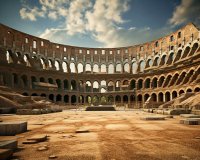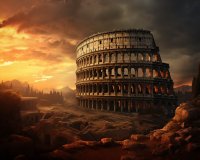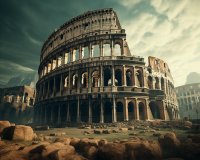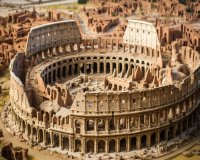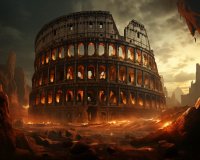Ancient Marvels of Rome
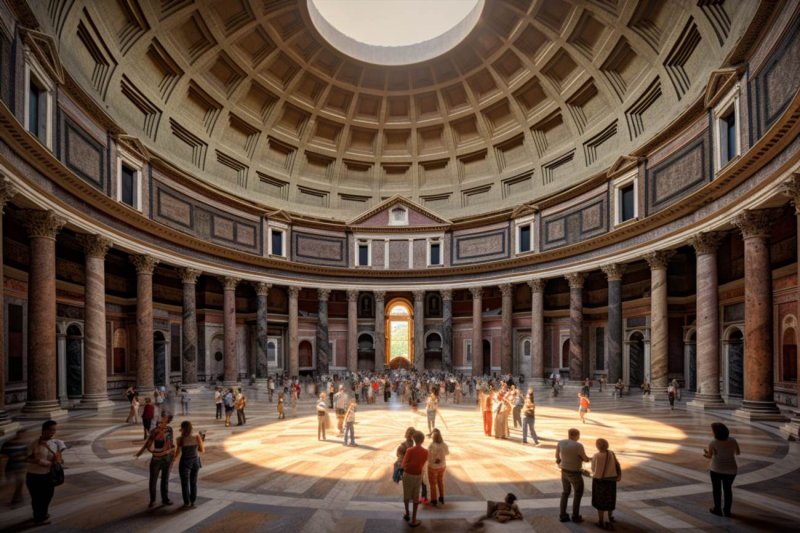
The Ancient Marvels of Rome
Rome, the eternal city, stands as a testament to the grandeur and ingenuity of ancient civilizations. Its rich history is marked by numerous marvels that have captivated the world for centuries.
Colosseum: Icon of Ancient Spectacle
The Colosseum, an iconic amphitheater, is a symbol of Roman engineering prowess. Built in the 1st century AD, it could hold up to 80,000 spectators who gathered to witness gladiatorial contests, animal hunts, and mock sea battles. The Colosseum's elliptical shape and tiered seating remain awe-inspiring architectural feats.
Pantheon: Temple of the Gods
The Pantheon, a majestic temple dedicated to all the gods of ancient Rome, boasts a remarkable dome that was the largest of its kind for centuries. Constructed in 126 AD, its design and engineering brilliance continue to inspire architects today. The oculus, an opening at the top, allows sunlight to illuminate the interior in a divine manner.
Roman Forum: Political and Social Hub
The Roman Forum served as the heart of ancient Rome, hosting political, religious, and social activities. Surrounded by important government buildings, temples, and basilicas, it was a bustling center of public life. Walking through its ruins today provides a glimpse into the daily life of the Roman citizens.
Arch of Constantine: Triumphal Symbol
The Arch of Constantine, erected in the 4th century AD, commemorates Emperor Constantine's victory. It is adorned with sculptures and reliefs depicting scenes of military triumph and is a testament to the grandeur of Roman triumphal arches.
Roman Aqueducts: Ingenious Water Supply System
Rome's aqueducts are engineering marvels that supplied the city with water for centuries. The Aqua Claudia, built in the 1st century AD, is a prime example. The intricate network of arches and channels transported water from distant sources, showcasing the Romans' mastery of hydraulic engineering.
Conclusion
These ancient marvels of Rome stand as enduring symbols of a civilization that left an indelible mark on history. From the grandeur of the Colosseum to the spiritual aura of the Pantheon, each structure tells a story of innovation, power, and cultural richness.
Rome: Discover the Ancient Wonders - Guided Tour to Roman Forum and Palatine Hill
Embark on an enriching journey through time as you join a guided walking tour to the Roman Forum and Palatine Hill in the heart of Rome. Marvel at the ancient ruins and absorb the profound history of these iconic landmarks with the expertise of a seasoned guide.
Ascend Palatine Hill and be captivated by panoramic vistas of the ruins below. Delve into the House of Augustus and admire an array of mesmerizing frescoes, offering profound insights into the grandeur of ancient Rome and its rulers.
Explore the Roman Forum, once a hub of triumphal processions, elections, and riveting public speeches in antiquity. Behold the architectural marvels like the Temple of Romulus as you traverse this historically significant site. Your knowledgeable guide will regale you with captivating tales of the Forum and its significance.
Highlights:
- Discover the Roman Forum, an ancient center of Roman public life.
- Gain breathtaking views from atop Palatine Hill.
- Immerse yourself in the rich history guided by an expert.
Inclusions:
- Visit to Palatine Hill
- Skip-the-line ticket to the Roman Forum
- Guided tour with individual headphones
Exclusions:
- Hotel pickup and drop-off
- Food and drinks
- Tips (optional)
Make your way to the meeting point at Via Frangipane 30, where your adventure through time begins. Unveil the stories of an ancient civilization that have shaped the course of history, leaving an indelible mark on the eternal city of Rome.
Roman Architecture in Rome
Roman architecture is a testament to the skill, innovation, and grandeur of the ancient Romans. With Rome as its epicenter, Roman architecture played a vital role in shaping the development of architectural styles for generations to come.
The Romans were known for their engineering prowess, creating awe-inspiring structures that combined functionality and aesthetics. The evolution of Roman architecture can be categorized into several distinct phases, each contributing to the city's remarkable skyline.
Early Roman Architecture
In the early years of Rome, architecture was heavily influenced by neighboring civilizations such as the Etruscans and Greeks. The Romans adopted and adapted elements of their architectural styles, incorporating arches, vaults, and columns into their buildings.
One of the most iconic early Roman structures is the Colosseum, also known as the Flavian Amphitheatre. This colossal amphitheater showcased Roman engineering prowess and remains a symbol of Rome's architectural and cultural heritage.
Imperial Roman Architecture
During the Roman Empire, the architectural style evolved and became more sophisticated. The use of concrete allowed the Romans to create monumental structures with intricate detailing and grandeur.
The Pantheon, a magnificent temple dedicated to all Roman gods, is a prime example of this era's architectural brilliance. The dome of the Pantheon, constructed with unreinforced concrete, stands as a marvel of engineering even to this day.
Urban Planning and Infrastructure
Beyond individual structures, Roman architecture encompassed urban planning and infrastructure development. Rome boasted an intricate network of roads, aqueducts, and public baths.
The Roman Forum, a central hub for public life, featured numerous government buildings, temples, and gathering spaces. It was a prime example of Roman urban planning, illustrating their mastery in organizing and designing city centers.
Influence on Modern Architecture
The legacy of Roman architecture is deeply ingrained in modern-day structures and design principles. Elements such as columns, arches, and domes continue to be prominent features in many buildings around the world.
Architects and designers draw inspiration from Roman architecture, adapting its timeless appeal to contemporary styles, ensuring that the grandeur and elegance of Rome's architectural heritage live on.
In conclusion, Roman architecture in Rome stands as a testament to the ingenuity and artistic vision of the ancient Romans. From the grand Colosseum to the enduring Pantheon, these architectural marvels have left an indelible mark on the world, shaping the course of architectural history for generations.
Rome: Palatine Hill & Roman Forum Ticket with Multimedia Video
Explore the ancient wonders of Palatine Hill and the Roman Forum at your own pace with pre-booked tickets. Immerse yourself in the centuries-old history of Rome through an insightful multimedia video.
About this ticket
Free cancellation - Cancel up to 24 hours in advance for a full refund
Reserve now & pay later - Keep your travel plans flexible — book your spot and pay nothing today.
Special health and safety measures are in place. Check your activity voucher once you book for full details.
Valid 1 day - Check availability to see starting times.
Wheelchair accessible
Highlights
- Enjoy the Roman Forum and Palatine Hill
- Enjoy 25-minute multimedia video
- Imagine the heart of the Roman political, social, and religious life at the Forum
- See panoramic views of Rome from Palatine Hill, including the Colosseum
Start your experience at the local partner's office, where you'll pick up your tickets and enjoy a 25-minute multimedia video about ancient Rome. With your ticket, discover Roman Forum and Palatine Hill. Visit the Roman Forum to see the tomb of emperor Julius Caesar and explore the ancient ruins at your own pace.
Your ticket also includes entrance to Palatine Hill, the site of the foundation of Rome, and the settlement of the most important houses of emperors and kings. Located just feet away from the Roman Forum and Circus Maximum, it is the centermost of the 7 hills of Rome.
Includes
- Reserved entrance to the Roman Forum and Palatine Hill
- 25-minute ancient Rome multimedia video
Please exchange your voucher for your ticket at the Touristation office (Piazza d'Aracoeli, 16). Do not report at the entrance of the Roman Forum entrance. Look for a building undergoing refurbishment, a small fountain, and orange flags outside the office.
Important information
- For security reasons, all visitors and their luggage will be screened
- It is forbidden to bring bottles, glass containers, alcoholic beverages, aerosols, large luggage or bags, and pets
Art and Sculptures of Rome
Rome, the eternal city, is not only known for its rich history and stunning architecture but also for its remarkable art and sculptures. From ancient masterpieces to contemporary works, Rome is a treasure trove of artistic expression that has captivated the world for centuries.
Ancient Roman Sculptures
When one thinks of Rome, the mind often drifts to the grandeur of the Roman Empire and the art that defined its era. The Romans were masterful sculptors, and their sculptures stand as a testament to their artistic prowess. The ancient Roman sculptures predominantly focused on realistic depictions of emperors, heroes, and mythological figures. The most famous among these is the Laocoön and His Sons, a Hellenistic marble sculpture that beautifully captures the agony of the Trojan priest and his sons.
The Vatican Museums
Rome is home to the Vatican Museums, a treasure chest of art and sculptures. The Sistine Chapel, adorned with Michelangelo's breathtaking frescoes, is undoubtedly the highlight. The Creation of Adam, with its iconic image of God and Adam's outstretched hands, is a masterpiece that continues to inspire artists and admirers alike.
Adjacent to the Sistine Chapel is the Raphael Rooms, where the works of the brilliant painter Raphael can be admired. The School of Athens, a fresco that brings together great philosophers and thinkers of antiquity, is a visual representation of human knowledge and wisdom.
The Baroque Marvels
The Baroque period left a significant mark on Rome, and the city boasts several splendid sculptures from this era. Gian Lorenzo Bernini, the prolific Baroque artist, is known for his masterpieces such as the Ecstasy of Saint Teresa, which can be found in the Santa Maria della Vittoria. This sculpture portrays the mystical experience of the saint and is a prime example of the emotive power of Baroque art.
Another famous Bernini sculpture is the Fountain of the Four Rivers in the Piazza Navona. The fountain represents four great rivers: the Nile, the Ganges, the Danube, and the Rio de la Plata, symbolizing the four continents known at the time. It's an exquisite blend of art, architecture, and symbolism.
Modern and Contemporary Art
Rome isn't just about its ancient and Baroque treasures; it's a dynamic city that embraces modern and contemporary art as well. The MAXXI - National Museum of 21st Century Arts is a prime example. This striking building designed by Zaha Hadid houses a diverse collection of contemporary art, architecture, and design.
Additionally, the city's streets and neighborhoods are adorned with graffiti, murals, and street art that reflect the vibrant and ever-evolving art scene. Artists from all over the world come to Rome to leave their mark on the city's urban canvas.
Conclusion
Rome's art and sculptures are a testament to the city's enduring cultural significance. From the awe-inspiring creations of ancient Rome to the emotional power of the Baroque period and the contemporary art scene, Rome is a living gallery that continues to inspire and enchant art enthusiasts from around the globe.


